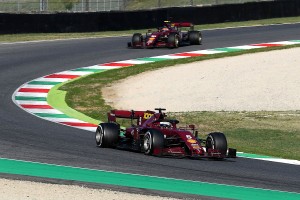
Formula 1 fans have been treated to something rare and precious over the last 3 weeks: consecutive races at fast, flowing, dangerous and positively sublime race tracks. First Spa-Francorchamps, then Monza, and now the absolute revelation that is Mugello.
It’s easy to watch much of the F1 season without appreciating what Formula 1 cars are actually made for. Yes, they’re stunningly fast in a straight line. Yes, they can brake in sickeningly short distances from high speed to virtually nothing. Those things are impressive, particularly when seen from the side of the track. But those things are not really the main trick Formula 1 cars do.
Formula 1 stands above all other racing series in one particular respect: the cars are able to corner at massive speeds. They can change direction at such high speed that it almost defies comprehension.
At many of the newer circuits on the F1 calendar, this trait of Formula 1 cars is barely on display. The formula for creating overtaking is the combination of long straights and heavy braking zones into slow corners. So that’s what modern circuit designers generally provide. Sequences of medium- to high-speed corners are out of favour because they don’t create close racing. F1 cars struggle to follow each other closely through high speed corners because the aerodynamic wake from the car in front compromises the aerodynamic performance of the car behind.
Enter Autodromo Internazionale del Mugello.
Located in Tuscany in Italy and owned by Ferrari, Mugello is a racer’s dream. A 1km long straight ends in a banked turn 1 which allows for enough grip around the outside for some ballsy overtaking, followed by 2 successive left/right combinations of corners and then the mouth-watering high speed sequence of turns 6 to 9 that shows off the downforce produced by F1 cars to perfection.
Another medium speed combination of turns 10 and 11 precedes the long, more than 180-degree right hander of turn 12, which is followed by a high-speed chicane of turn 13 and then the long, left-hand final corner that builds up speed back onto the long main straight.
The only rest the drivers get around then entire lap is on the main straight. And even when they’re flying over the start-finish line, they need to be defending against the attack that inevitably comes from chasing cars over a long straight. It’s hard work from start to finish and absolutely epic to watch.

In today’s Tuscan Grand Prix, won by Lewis Hamilton, the toll on the drivers was visible. Despite having two breaks when the race was red flagged for big crashes, the drivers emerged from their cars at the end exhausted. The standards of fitness are so high in Formula 1 that most drivers finish most races looking like they could get back in the car and have another go. Not so at Mugello.
Hamilton was visibly drained after the race, and was slow getting out of his Mercedes, taking a few minutes to remove his helmet and wipe his face before gently climbing out of the car. It was a very different scene to Hamilton’s typical energetic bounding out of the car to celebrate with the team and the fans.
In the style of many older tracks, Mugello is not only fast and flowing: It’s also brutal in punishing failure on the part of cars and drivers. Lance Stroll found this out to his cost when something broke on his Racing Point on entry to the high speed Arabbiata 2 turn 9. It looked like either Stroll’s left rear tyre deflated suddenly or the suspension collapsed as he turned into the high-speed right hand corner. There was no chance of keeping the car on the track and Stroll , through no fault of his own, found himself hurtling through the gravel trap towards the tyre barrier on the outside of the corner. Although he walked away from the crash, Stroll took a while to climb out of the car, presumably shaken by what appeared to be a significant impact.
2020 is the first year a Formula 1 race has been held at Mugello. It’s been an unusual season, full of uncertainty and improvisation in planning due to the Covid-19 pandemic. Mugello was not originally even under consideration for a Grand Prix this year, but was added to the calendar due to its availability and its FIA Grade 1 status that makes it eligible for Formula 1.

It was fortuitous that the addition of Mugello to the 2020 F1 calendar allowed for it to be the scene of Ferrari’s 1000th Formula 1 race. The only team to have competed since the very first season in 1950 (although they did not take part in the first F1 race held at Silverstone that year), Ferrari are an invaluable treasure in the sport, providing so much of the passion and commitment that makes Formula 1 the thrilling sport it is. It was fitting that they should celebrate this milestone at the circuit they own and operate, and appropriate that both Ferraris finished in the points, something that has not been a given so far in a particularly difficult season for the illustrious team.
If today’s race is anything to go by, there will be a great deal of popular support from the fans, and probably the teams and drivers too, for the inclusion of Mugello in future F1 seasons. What a spectacular venue for motor racing!


Leave a comment